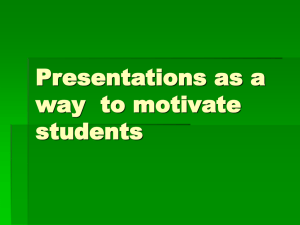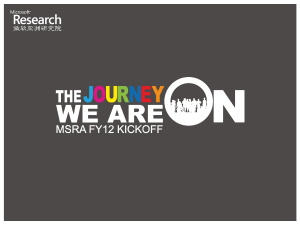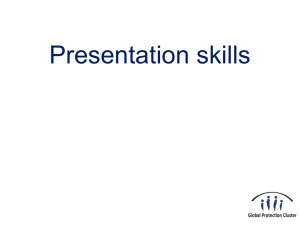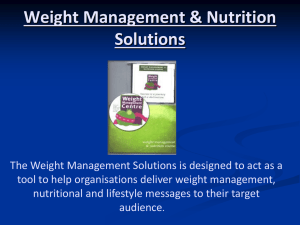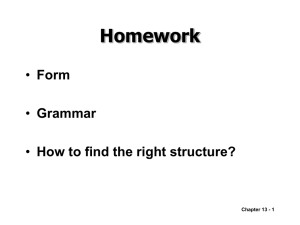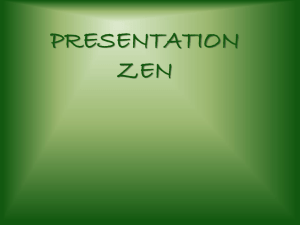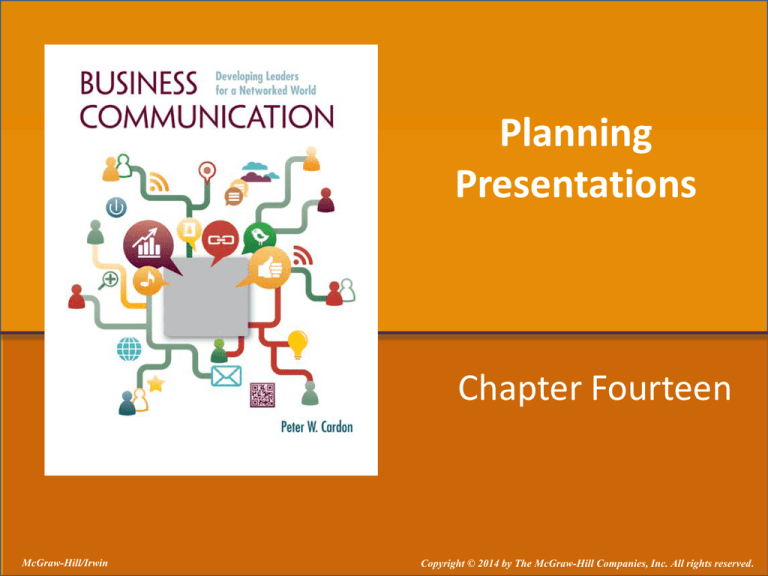
Planning
Presentations
Chapter Fourteen
McGraw-Hill/Irwin
Copyright © 2014 by The McGraw-Hill Companies, Inc. All rights reserved.
Learning Objectives
LO14.1 Describe how planning your
presentations leads to credibility.
LO14.2 Analyze presentation audiences in terms
of message benefits, learning styles,
and communicator styles.
LO14.3 Organize and gather content for a
preview, view, and review.
14-2
Learning Objectives
LO14.4 Develop effective slide presentations.
LO14.5 Use the story line approach to
presentations.
LO14.6 Evaluate your presentations for fairness
and effectiveness.
14-3
Planning the Content of
Your Presentation
Analyze your audience to make sure you’re
addressing their needs and speaking to them
in the way that is most appealing and easy to
learn.
14-4
Planning the Content of
Your Presentation
Develop your ideas
by identifying the key
facts and conclusions
related to your topic
14-5
Planning the Content of
Your Presentation
Construct your message to focus on the key
takeaway concepts and to provide supporting
points throughout
14-6
Analyze Your Audience
How Will Audience Members Benefit from the
Product, Service, or Ideas I Am Proposing?
What Do the Audience Members Already Know
about My Product, Service, or Ideas?
What Are My Audience Members’ Chief
Concerns?
14-7
Analyze Your Audience
Who Are the Key Decision Makers?
What Will Appeal to Your Audience?
What Is the Learning Style of Your Audience?
14-8
Who Are the Key
Decision Makers?
For internal presentations, think about those
individuals who have the most influence and
authority to act on your ideas
For presentations to clients, customers, and
prospects, think about who you perceive as
the most likely prospects for future business
14-9
What Will Appeal to
Your Audience?
Oral communications, especially speeches
and presentations, are well suited to strong
emotional appeal
Your speeches and presentations will also
include a set of ideas that you want your
audience to appreciate analytically
14-10
What Will Appeal to
Your Audience?
Sensers will
appreciate your
ability to stay on
point and discuss
immediate goals.
Feelers will
appreciate your
ability to discuss
business
relationships
14-11
What Will Appeal to
Your Audience?
Thinkers will
appreciate your
ability to provide all
of the facts and avoid
rushing to judgment
about conclusions
Intuitors will
appreciate your
ability to present
visionary ideas
14-12
What Is the Learning Style
of Your Audience?
Visual learners
learn best from
illustrations and
simple diagrams to
show relationships
and key ideas
make up about 40
percent of the
population
14-13
What Is the Learning Style
of Your Audience?
Auditory learners
Kinesthetic learners
like loud, clear voices
need to participate to
and believe emotion
is best conveyed
through voice
comprise roughly 40
percent of the
population
focus their attention
on your message and
learn best
make up about 20
percent of the
population
14-14
Identify a Few Takeaway Messages
Once you’ve developed two or three key
messages, everything in the presentation
should lead back to them
Summarize your key takeaway messages at
the outset and reemphasize them several
times
14-15
Structure Your Presentation with a
Clear Preview, View, and Review
Typically, your preview occupies roughly 10 to 15
percent of your presentation time
Your view takes up the vast majority
(85 to 90 percent) of your time
The review takes up the least time
(5 percent).
14-16
Provide a Compelling Preview
Create interest
Show benefits
Demonstrate value
Encourage action
14-17
Attention-Getters
Rhetorical
questions
Vivid
examples
Dramatic
demonstrations
Testimonials
or
quotations
Intriguing
statistics
Unexpected
exercises
Challenges
14-18
Creating a Positioning Statement
Positioning
statement
frames your message
in appealing terms to
your audience
members and
demonstrates clear
and valuable benefits
to them.
14-19
Providing an Overview Statement
Ideally, you can state your overview in one to
three sentences in simple, conversational
language
An overview segments the presentation in
terms of key benefits or takeaway messages
14-20
PREP Method
State your position
Provide the reasons
Give an example
Restate your position
14-21
The PREP Method
14-22
Conclude with an Effective Review
Make sure to have a strong finish
Recap your message in just a few sentences
Provide a call to action
14-23
Avoiding Death by PowerPoint
Figure 14.1
14-24
Setting Up Slide Titles to Help You
Make a Smooth, Logical Presentation
14-25
Design Your Slides for
Ease of Processing
Limit the amount of information on any given
slide
Use font sizes that all audience members can
read easily
Focus on and highlight key information
Use plenty of white space
14-26
Design Your Slides for
Ease of Processing
Use high-contrast backgrounds and colors
Use compelling images in moderation
Develop simple charts and diagrams
Get professional design help when possible
14-27
Applying the Story Line Approach
to Your Presentations
The story line allows your listeners to engage
on a deeper level emotionally and
intellectually
People remember stories more easily than
they do abstract information, and they are
more likely to act on what they hear via
stories.
14-28
Applying the Story Line Approach
to Your Presentations
Plot
Setting
Resolution
Moral or
lesson
14-29
Are Your Presentations FAIR?
14-30

